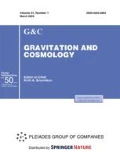Abstract
One of the most accepted ideas in modern cosmology to explain a number of puzzling astronomical observations is the existence of Dark Matter in the Universe, even though it has not been directly observed. We recall the motivation for its existence according to its influence on visible matter and its characteristics in terms of famous candidate particles.
Similar content being viewed by others
References
A.K. Raychaudhuri, S. Banerji, and A. Banerjee, General Relativity, Astrophysics, and Cosmology (Springer-Verlag, New-York, 1992).
J. V. Narlikar, An Introduction to Cosmology (Cambridge University Press, Cambridge, 2002).
S. Weinberg, Cosmology (Oxford University Press, Oxford, 2008).
D. N. Spergel et al., “First year of WMAP observations: determination of cosmological parameters,” Astrophys. J. Suppl. Series, 148, 1 (2003).
M. Tegmark et al., “Cosmological parameters from SDSS and WMAP,” Phys. Rev. D. 69, 10 (2004).
G. Bertone, D. Hooper, and J. Silk, “Particle Dark Matter: evidence, candidates and constraints,” Phys. Rep. 405, 5–6 (2005).
P. Fayet and S. Ferrara, “Supersymmetry,” Phys. Rep. 32, 5 (1977).
C. Autermann, “Experimental status of supersymmetry after the LHC Run-I,” Progress in Particle and Nuclear Physics 90, 125 (2016).
F. Zwicky, “Spectral displacement of extra galactic nebulae,” Helv. Phys. Acta 6, 110 (1933).
V. C. Rubin and W K. Ford, “Rotation of the Andromeda nebula from a spectroscopic survey of emission regions,” Astroph. J. 159 379, (1970).
J. D. Simon, A. D. Bolatto, A. Leroy, L. Blitz, and E. L. Gates, “High-resolution measurements of the halos of four Dark Matter-dominated galaxies,” Astroph. J. 621, 757 (2005).
J. F Navarro, C. S. Frenk, and S. D. M. White, “The atructure of cold Dark Matter halos,” Astroph. J. 462, 563 (1996).
B. Moore, F. Governato, T. Quinn, J. Stadel, and G. Lake, Resolving the structure of cold Dark Matter halos,” Astrophys. J. 499 L5 (1998).
A. Gando et al., “Enhanced constraints on 13 from a three flavor oscillation analysis of reactor antineutrinos at KamLAND,” Phys. Rev. D 83, 052002 (2011).
D. M. Wittman et al., “Detection of weak gravitational lensing distortions of distant galaxies by cosmic dark matter at large scales,” Nature. 405, 143 (2000).
G. Gamow, “Expanding universe and the origin of elements,” Phys. Rev. 70, 572 (1946).
A. A. Penzias and R. W Wilson, “A measurement of excess antenna temperature at 4080-Mc/s,” Astroph. J. 142, 419 (1965).
C. L. Bennett etal., “Cosmic temperature fluctuations from two years of COBE differential microwave radiometers observations,” Astroph. J. 436, 423 (1994).
“Planck 2018 results. I. Overview and the cosmological legacy of Planck-Planck collaboration,” Nature 553, 7689 (2018).
M. Milgrom, “A modification of the Newtonian dynamics as a possible alternative to the hidden mass hypothesis,” Astroph. J. 270, 365 (1983).
D. Clowe, A. Gonzalez, and M. Markevitch. “Weak lensing mass reconstruction of the interacting cluster 1E0657-558: Direct evidence for the existence of dark matter,” Astroph.J. 604, 2 (2004).
D. Clowe et al., “A direct empirical proof of the existence of dark matter,” Astrophys J. 648, 2 (2006).
J. D. Bekenstein, “Relativistic gravitation theory for the MOND paradigm,” Phys. Rev. D 70, 083509 (2004).
G. W Angus, H. Y. Shan, H. S. Zhao, and B. Famaey, “On the law of gravity, the mass of neutrinos and the proof of dark matter,” Astroph. J. 654, L13 (2007).
J. L. Feng, A. Rajaraman, and F. Takayama, “Superweakly interacting massive particles,” Phys. Rev. Lett. 91, 011302 (2003).
J. L. Feng, S. f. Su, and F. Takayama, “SuperWIMP gravitino Dark Matter from slepton and sneutrino decays,” Phys. Rev. D 70, 63514 (2014).
C. Arina and N. Fornengo, “Sneutrino cold dark matter, a new analysis: relic abundance and detection rates,” JHEP 11, 029 (2007).
D. Cerdeno, C. Munoz, and O. Seto, “Right-handed sneutrino as thermal Dark Matter,” Phys. Rev. D. 79, 023510 (2008).
H. Pagels and J. R. Primack, “Supersymmetry, cosmology and new TeV physics,” Phys. Rev. Lett. 48, 223 (1982).
M. Pospelov, Particle physics catalysis of thermal Big Bang nucleosynthesis,” Phys. Rev. Lett. 98, 23 (2007).
S. Dimopoulos and H. Georgi, Nucl. Phys. B 193, 1 (1981).
G. R. Farrar, and P. Fayet, Phys. Lett. B. 76, 5 (1978).
R. D. Peccei and H. R. Quinn, “CP, conservation in the presence of pseudoparticles,” Phys. Rev. Lett. 38, 1440 (1977).
G. Ballesteros, J. Redondo, A. Ringwald, and C. Tamarit, JCAP 08, 001 (2017).
B. Carr, “Primordial black holes as dark matter and generators of cosmic structure,” arXiv: 1901.07803.
H. E. Haber and D. Wyler, “Radiative neutralino decay,” Nucl. Phys. B. 323, 267 (1989).
G. Jungman, M. Kamionkowski, and K. Griest, “Supersymmetric Dark Matter,” Phys. Rep. 267, 195 (1996).
F. Calore, P. D. Serpico, and B. Zaldivar, “Dark matter constraints from dwarf galaxies: a data-driven analysis,” JCAP 10, 029 (2018).
P. Agrawal, B. Batell, P. J. Fox, and R. Harnik, “WIMPs at the galactic center,” JCAP 1505, 2015 (2014).
S. Ando and D. Nagai, “Fermi-LAT constraints on Dark Matter annihilation cross-section from observations of the Fornax cluster,” JCAP. 1217, 017 (2012).
R. Bernabei et al., First results from DAMA/LIBRA and the combined results with DAMA/NaI,” Euro Phys. J. C 56, 3 (2008).
TEXONO Collaboration: S. T. Lin et al., “New limits on spin-independent and spin-dependent couplings of low-mass WIMP Dark Matter with a germanium detector at a threshold of 220 eV,” Phys. Rev. D. 79, 061101 (2009).
A. Ventura, “Recent results from SUSY searches with ATLAS and prospects for the HL-LHC,” ATL-PHYS-PROC. 022, 6 (2019).
G. Aad et al. [ATLAS Collaboration], Phys. Lett. B. 716, 1 (2012).
S. Chatrchyan et al. [CMS Collaboration], Phys. Lett. B 716, 30 (2012).
Acknowledgments
The authors are grateful to their families for support.
Author information
Authors and Affiliations
Corresponding author
Additional information
The present issue of the journal is No. 100 since it was founded in 1995.
Rights and permissions
About this article
Cite this article
Ennadifi, S.E., Douhou, K. Dark Matter Particles: Properties and Detections. Gravit. Cosmol. 25, 310–318 (2019). https://doi.org/10.1134/S0202289319040054
Received:
Revised:
Accepted:
Published:
Issue Date:
DOI: https://doi.org/10.1134/S0202289319040054




